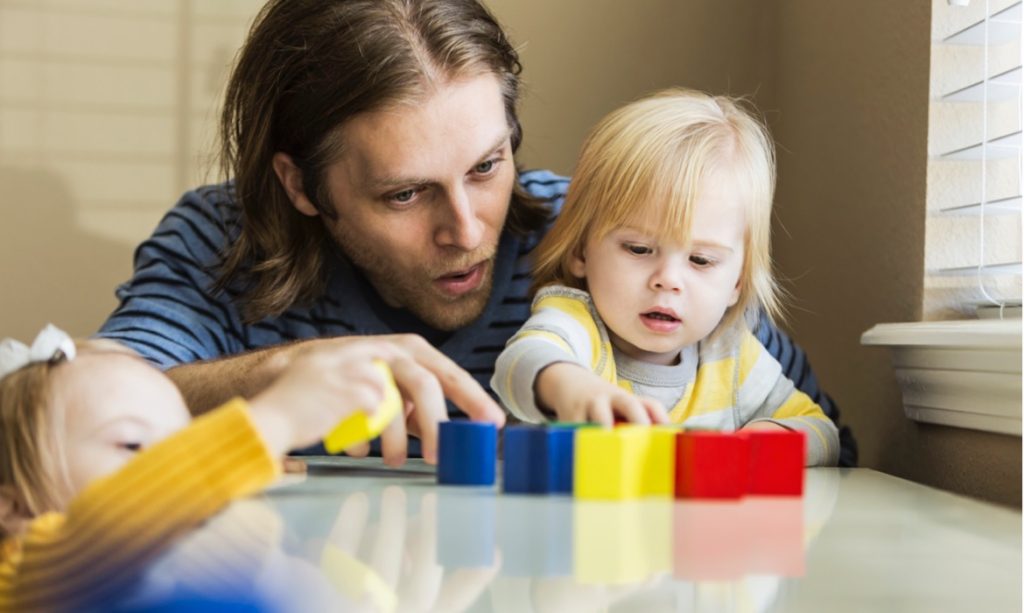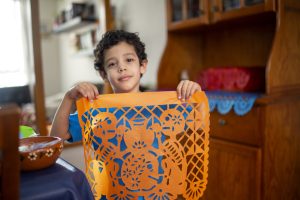- Math is “hiding” in many everyday family activities (we offer tips for finding it).
- Parents and caregivers support their children’s math development when they notice and talk about math in their daily routines.
- Deepen children’s math thinking by expanding comments and asking questions.
There are many opportunities in daily life to encourage young children to think mathematically. These early math learning opportunities can be informal and playful additions to family routines. Math is “hidden” in so much of what we already do, such as when reading books, preparing meals, going for walks, doing chores, or playing games.
How can parents and caregivers take advantage of hidden math in a way that helps children expand their mathematical thinking? Here we propose four steps:
1. Notice the Math
The first step in revealing hidden math is to notice the math in everyday activities. For example, caregivers and their children can recognize or name numbers, count objects, add or subtract, notice patterns, compare shapes and sizes of things, or use math to measure or solve problems like, “How many more cups do we need so everyone has one?”
This kind of mathematical thinking often occurs during playtime. In our research, we found that the type of play families engage in relates to what math concepts families notice and talk about. [1] For example, parents and children are more likely to practice counting skills when playing a board game compared to when they play with blocks. But they are more likely to practice measurement skills, such as how tall or long something is, when playing blocks than when playing board games.
Regardless of what you are playing, make a point to notice the math. After some practice finding the math, it may not feel so hidden anymore!
2. Talk About the Math
Once you notice the math in everyday life, point out the math to children. When children point out math to you, use that as a starting point to extend their math learning. These conversations build children’s math vocabulary and help them practice key early math skills.
In our research, we found that parents and children both spontaneously commented on many different math concepts. They made observations about the number, shape, size, and position of things, such as whether a blue block is next to or on top of a red block. [1] These important interactions can happen in many everyday activities, including playtime. Parents can use these comments to start a math conversation.
3. Ask Questions and Have Conversations
Try to expand on math comments and keep conversations going by asking questions. This encourages children to think more deeply about math ideas. For example, parents can take a statement like, “That’s a square,” and turn it into a question: “Are these two blocks the same shape or different shapes? How come?” Notice how this question encourages children to think about why the shape is a square.
Parents can use comments and questions to promote early math exploration in many areas of everyday life, such as when:
- Playing with toys: What can fit inside the house? I wonder what will happen if you turn Teddy another way?
- Playing pretend games: How can we share the watermelon? We can make a rainbow pattern with these colorful fruits!
- Preparing meals: How many plates do we need so everyone has a plate?
- Gardening: Let’s see how far apart we need to plant the seeds. How can we measure the distance?
- Waiting in line: How many people are in front of us? Which line is the shortest?
These math interactions in everyday activities are brief, but they create opportunities for children to practice and develop math skills on their own. For more ideas finding math in everyday life, check out DREME Math Snacks.
4. Model and Praise Problem-Solving
Parents can model problem-solving and praise their children when they practice problem-solving. For example, you could:
Talk out loud to show how you solve a math problem. “There’s one for you, one for me, and one for Ashley, so that’s 3!”
Focus on your children’s problem-solving instead of whether they are right or wrong. For example, when your child guesses that a tree is “100 steps” away, you can reply, “100 steps is very far, and you are right that the tree is very far from us. I wonder how far? Let’s count and figure it out.”
Offer specific praise for your children’s effort. “You’re really figuring that out!”
Here again, caregivers may encourage deeper thinking with questions like:
- How can we figure it out?
- What’s another way we can try?
- What do you notice?
- What is the same? What is different?
- Tell me what you are thinking!
When caregivers notice the math, talk about the math, ask questions, and use math for problem-solving, both caregivers and children can deepen their appreciation for math in their daily lives.
[1] Chan, J. Y. C., Praus-Singh, T. L., & Mazzocco, M. M. M. (2020). Parents’ and young children’s attention to mathematical features varies across play materials. Early Childhood Research Quarterly, 50(3), 65–77. https://doi.org/10.1016/j.ecresq.2019.03.002



